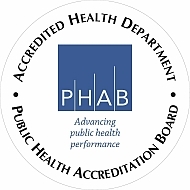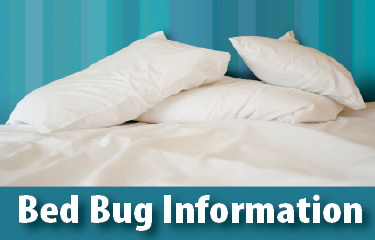|
A bed bug is a small insect that feeds on the blood of humans and animals. They are flat and oval shaped, have no wings, and can be different colors depending on how old they are. Young bugs may look clear, while older bugs may appear straw color to dark brown. The bugs can vary in size, from the size of a period at the end of a sentence up to the size of an apple seed.
Bed bugs like to live in dark hidden places. Often they can be found in the folds of mattresses, bedding, clothing and carpets. They can move from places with a large number of bed bug to new locations by getting into bags and luggage or attaching to clothing. The bugs can even find their way through walls, floors, and ceilings, so it’s important that bed bugs be taken care of before they spread.
Bed bugs survive by biting humans and animals and feeding on their blood. These bites cause itchy red bumps on the skin. These bites can be uncomfortable, but are not known to carry any diseases. Usually the bites are not serious and will heal within a week or two. Rarely, some people may have a reaction to the bites that can cause them to swell into large sores or cause blister-like skin sores. If you have bites, a cream can be used to reduce itching. Consult your doctor if you have any serious reactions to the bites.
Most people will first become aware of bed bugs if they have been bitten. You can check for bed bugs by looking at the seams of mattresses, pillows, and bedding. Specks of blood or signs of bug feces on sheets and mattresses may be signs of a bed bug problem. You may also notice a strong sweet odor. Checking at night is important since this is when the bugs are most active.
Bed bugs prefer to bite people, but they will bite mice, rats, bats and birds. Cats and dogs can be bitten, but are not a major host.
When travelling, check mattress seams. Wash all clothing when you return home. Carefully check any used furniture, clothing and electrical devices before bringing them into the home. Never bring in discarded mattresses or furniture.
Eliminating bed bugs requires aggressive cleaning of affected areas and usually pesticide application. It will take repeated treatments. There is no one-time quick fix. It is recommended that you hire a licensed pest control operator with bed bug experience.
- Locate bed bug hiding places. Use a flashlight to check the mattresses, especially along seams, buttons and folds. Check the cracks on the bed frame. You can use a hair dryer on high to force them from cracks. Bed bugs may move to any cracks in the room. Check cracks in the baseboard, around outlets, peeling paint or wallpaper, window trim and furniture.
- Vacuum the affected areas thoroughly. Seal the vacuum bag in a plastic bag and dispose of the bag. Vacuum the affected areas several times a week.
- Remove clutter and objects bed bugs could hide in.
- Dressers and furniture: Clean out drawers and check for bed bugs. Keep as little as possible in drawers to monitor activity. Clothes may be placed in plastic bags.
- Move the bed away from the wall. Keep bed linens and bed skirts from touching the floor. Some literature suggests putting petroleum jelly or double-sided tape on the bed legs or putting the bed legs in a container of water.
- Wash any suspect linens or clothing in the hottest water possible for the fabric and dry in the hottest dryer possible for the fabric. Bed bugs are heat sensitive and will be killed at temperatures of 140 degrees F for 20 minutes.
- Steam cleaning of cracks and crevices can be effective. Do not steam clean mattresses.
- Mattresses: Vacuum thoroughly. Don’t apply pesticides to a mattress. You can put the mattress into a plastic, waterproof, zippered mattress cover labeled “allergen rated” or “for dust mites” and cover for at least a year. You may also choose to discard the mattress (see number 12, Disposal).
- Box Springs: Box springs are hollow and hard to treat. You can cover the box springs with the approved mattress cover for a year or properly dispose of the box spring. The plastic cover will need to be periodically inspected for rips or holes and repaired as necessary.
- New Bedding: Remember that any new unprotected bedding brought in before the bed bugs are eliminated will probably become infested.
- Seal as many cracks as possible in the affected area to reduce hiding places.
- Disposal: Bag and seal unwanted, infested clothing before disposal. Bag and seal all used vacuum cleaner bags. If you are disposing of infested mattresses or furniture, try to cut or disfigure so someone else will not pick it up. Tape a sign stating “Infested with Bed Bugs” to the item.
Pesticides can be dangerous. Use only as directed and follow instructions on the product or employ a certified pest control operator. Use only products labeled for bed bugs. Cockroach, ant and bee sprays are usually not labeled for bed bugs. Sprays are available at most hardware stores. Do not spray mattresses or sofas or chairs.
Onondaga County Health Department - Bed Bug Fact Sheet
NY State Department of Health (NYSDOH) - Bed Bugs What They Are and How to Control Them
Centers for Disease Control and Prevention (CDC) - Bed Bugs
CDC - Bed Bugs FAQs
NYC Depts. of Health & Mental Hygiene & Housing Preservation & Development - Preventing and Getting Rid of Bed Bugs Safely
|


